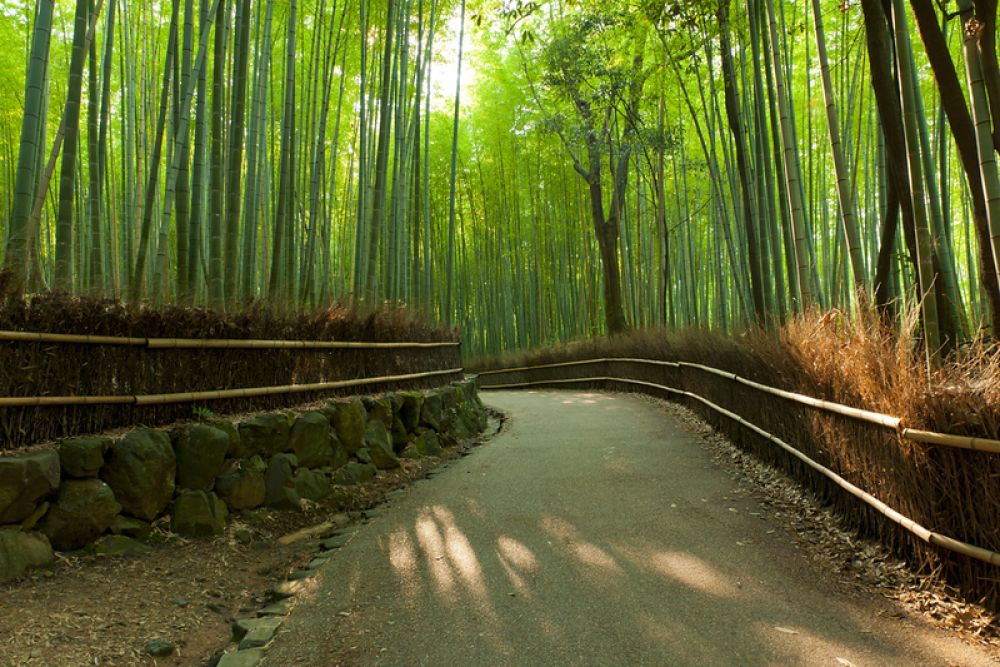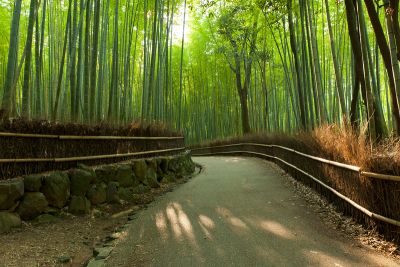

The Arashiyama Bamboo Grove is one of Kyoto's top sights and for good reason: standing amid these soaring stalks of bamboo is like being in another world. The walking paths that cut through the bamboo grove are its main draw, and they are simply impossible to resist. As you walk through the grove, the light filtering through the dense bamboo is soothing and otherworldly. It's most striking in the early morning or late in the day, when the grove is less crowded and the light is at its most magical. Aside from the aesthetic delight of seeing and moving through the bamboo, the sounds in the grove are an unanticipated pleasure. When the wind blows, the tall bamboo stalks sway back and forth, colliding and clacking against one another, creating a natural symphony that adds to the sense of enchantment in the place.
Tenryu-ji Temple is a World Heritage site and one of the 'Great Five' Zen temples of Kyoto. As the head temple of the Tenryu-ji branch of Rinzai Zen Buddhism, it holds significant historical and cultural importance. The temple offers a rare chance to explore a traditional Zen landscape garden, which remains in its original form since the 14th century. The Sogenchi pond garden, created by the famous garden designer Muso Soseki, is an exemplar of Zen garden design, incorporating borrowed scenery of the Arashiyama mountains. The garden is designed for meditation and contemplation, and its stunning features, including a walking path around the pond, is a testament to the connection between nature and spiritual practice. Exploring the temple buildings, you can witness beautifully painted sliding doors (fusuma) and other historical artifacts, deeply enriching your understanding of Zen Buddhism's role in Japanese culture.
Togetsukyo Bridge, known as the 'Moon Crossing Bridge,' has a history spanning several centuries and is a central landmark of the Arashiyama district. The bridge spans the Katsura River and offers breathtaking views of the forested hillsides which are particularly stunning during cherry blossom season and autumn leaf season. The iconic bridge has been the subject of many historical paintings and literary references. Walking across Togetsukyo is a serene experience, connecting you to the cultural heart of Arashiyama, and is often enjoyed as part of a larger exploration of the area's nature and historical sites. Visitors can enjoy a leisurely stroll across the bridge or take a rickshaw ride to feel transported back in time. The views from the bridge at sunset are particularly recommended for the way the light plays on the water and mountains, creating a picturesque scene that epitomizes the beauty of Kyoto's natural landscape.
The Iwatayama Monkey Park in Arashiyama is a must-visit for animal lovers and families. Situated on a mountain, the park is home to a troop of over 120 Japanese macaque monkeys, which roam freely in their natural habitat. The park offers a unique opportunity to interact with these animals in a respectful and close-up setting. Visitors usually hike up the mountain for about 20-30 minutes to reach the main viewing area where monkeys can be observed playing and feeding. A small hut provides safe indoor space where you can feed the monkeys through the grills. The top also offers dramatic, panoramic views of Kyoto and the surrounding areas. It's a perfect spot to take memorable photos. The experience is not only entertaining but is also educative, as you learn about the lives and habits of these fascinating creatures. Remember to follow park rules for your safety and the monkeys' well-being.
Kameyama-koen is a lovely park located in the western end of Arashiyama. While smaller and less renowned than some of the more significant temples and shrines, it provides a peaceful escape from the more crowded tourist sites. With a mix of open spaces, wooded areas, and paths skirting the edge of the river, it can be the ideal place for a leisurely walk or picnic, especially during cherry blossom season or the turning of the maple leaves in autumn. Historical landmarks are dotted within the park, like the remains of an old Meiji-era villa. The park has several vantage points offering superb river and mountain views. Kameyama-koen's relatively restful atmosphere compared to the buzzing main street of Arashiyama makes it an excellent spot for relaxation and tranquil reflection amidst nature.
Taking a traditional riverboat trip on the Hozugawa River is a thrilling way to experience the natural beauty of the Arashiyama region. The river winds through a valley flanked by lush, steep mountain sides, and the riverboat ride shows this off spectacularly. Originally used to transport goods and lumber, the Hozugawa riverboats have been ferrying passengers down this scenic route for over a hundred years. As you float down the river, experienced boatmen navigate the serenely flowing waters as well as exciting rapist carefully, making for an exhilarating and memorable journey. This river trip allows visitors to connect with the region's history while immersing themselves in the area's stunning seasonal transformations. Enjoy the wildness of spring floods or the vibrant red and gold foliage of autumn as the boat provides a unique vantage point that one can't experience from the shore.
The Kimono Forest is a visually stunning attraction located within the grounds of Randen’s Arashiyama Station. It consists of hundreds of cylindrical pillars lined up along the pathways, each draped in Kyo-yuzen style kimono fabrics. These pillars are lit up at night, creating a whimsical and romantic atmosphere that feels magical. The breathtaking display represents the diversity and beauty of traditional Japanese kimonos, showcasing patterns and colors that are historically significant to the Kyoto area. Walking through this 'forest', visitors can admire the craftsmanship and appreciate the historical importance of textile production to the city's cultural heritage. At the heart of the Kimono Forest, you'll find a small pond with a dragon statue, said to bring good luck to visitors who touch it. A visit to the Kimono Forest offers a unique artistic experience that is both modern and steeped in tradition.
Jojakko-ji Temple stands as a serene oasis nestled among the hills of Arashiyama, offering visitors a spiritual retreat with stunning panoramic views. Founded in the 16th century, the temple is known for its beautiful moss garden and the striking pagoda that overlooks the city. The ascent through the temple's gate, up the stone steps surrounded by vibrant maple trees, is meditative and provides a workout rewarding visitors with an increasingly impressive vista as they rise. The architecture of the temple serves as a testament to traditional Japanese design and its integration with nature. In autumn, the area surrounding the temple is ablarked to be one of Kyoto's best spots for fall foliage. Jojakko-ji Temple's peaceful environment, historical significance, and scenic beauty make it a must-visit for anyone seeking insight into Japan's religious heritage or simply a respite from life's daily hustle.
Visiting Okochi-Sanso Villa offers a luxurious glimpse into the life of a famous Japanese actor, Okochi Denjiro, who built this estate as a personal retreat. Comprised of several beautifully maintained gardens, traditional houses, and tea rooms, all set against the backdrop of the Arashiyama mountains, it is one of the area's hidden gems. The garden paths lead from one stunning view to another, including a sweeping vista over Kyoto. Each season brings its distinctive charms, from cherry blossoms in spring to the fiery foliage in autumn. Moreover, your visit includes a complementary matcha green tea and sweet, allowing you to experience a traditional tea ceremony in a serene setting. The villa's history, combined with the palpable sense of peace it offers, provides a fulfilling cultural experience for visitors who wish to appreciate Japan's natural beauty and artistic tradition.
